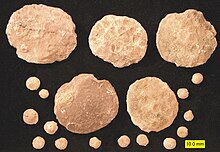Nummulite
| Nummulite Temporal range:
| |
|---|---|

| |
| Fossil nummulitid foraminiferans showing microspheric and megalospheric individuals; Eocene of the United Arab Emirates; scale in mm. | |
| Scientific classification | |
| Domain: | Eukaryota |
| Clade: | Diaphoretickes |
| Clade: | SAR |
| Phylum: | Retaria |
| Subphylum: | Foraminifera |
| Class: | Globothalamea |
| Order: | Rotaliida |
| Family: | Nummulitidae |
| Genus: | Nummulites Lamarck, 1801 |
| Species | |
|
Numerous | |
A nummulite is a large lenticular fossil, characterised by its numerous coils,[1] subdivided by septa into chambers. They are the shells of the fossil and present-day marine protozoan Nummulites, a type of foraminiferan. Nummulites commonly vary in diameter from 1.3 cm (0.5 inches) to 5 cm (2 inches)[2] and are common in Eocene to Miocene marine rocks, particularly around southwest Asia and the Mediterranean in the area that once constituted the Tethys Ocean, such as Eocene limestones from Egypt[3] or from Pakistan.[4] Fossils up to six inches wide are found in the Middle Eocene rocks of Turkey.[5] They are valuable as index fossils.
The ancient Egyptians used nummulite shells as coins and the pyramids were constructed using limestone that contained nummulites.[3][6] It is not surprising then that the name Nummulites is a diminutive form of the Latin nummulus 'little coin', a reference to their shape.[7]
In 1913, naturalist Randolph Kirkpatrick published a book, The Nummulosphere: an account of the Organic Origin of so-called Igneous Rocks and Abyssal Red Clays, proposing the unconventional theory that all rocks had been produced through the accumulation of forams such as Nummulites.
Gallery
[edit]-
'A Nummilite, viewed from above, and horizontally bisected'
Use
[edit]Because nummulites are fossils very abundant, easy to recognize and lived in certain biozones they are used as guide fossil. It is worth highlighting that thanks to the appearance of Nummulites tavertetensis in the Shallow Bentic Zone 15 (SBZ 15), it was possible to date the oldest fossil remains of Sirenio in Western Europe found in a new paleontological site, in Santa Brígida, Amer (La Selva, Catalunya, Spain) near an old quarry of stone limestone with nummulites.[8]
References
[edit]- ^ 'Nummulite', Tiscali Dictionary of Animals, retrieved 17 August 2004
- ^ Isquirth, Irwin Richard (2011). In The World Book Encyclopedia. print.
- ^ a b Kaplan, Sarah, Brilliance without a brain Archived 2018-03-08 at the Wayback Machine, Speaking of Science, The Washington Post, March 7, 2018
- ^ Banerjee, Santanu; Khanolkar, Sonal; Saraswati, Pratul Kumar (23 February 2018). "Facies and depositional settings of the Middle Eocene-Oligocene carbonates in Kutch". Geodinamica Acta. 30 (1): 119–136. Bibcode:2018GeoAc..30..119B. doi:10.1080/09853111.2018.1442609.
- ^ 'Biggest Microbes', Guinness World Records 2001, p. 153.
- ^ Isquirth, Irwin Richard (2011). In The World Book Encyclopedia. print.
- ^ Hottinger, Lukas (2006-09-08). "Illustrated glossary of terms used in foraminiferal research". Paleopolis. Archived from the original on 2012-06-21. Retrieved 2018-11-11.
- ^ Fuentes-Buxó, R., or, A. 2016. Troballa de restes de sireni al Lutecià (Eocè mitjà) de Santa Brígida (Amer, La Selva, Girona). Treballs del Museu de Geologia de Barcelona, 22: 19-24 .
Further reading
[edit]- Aigner, Thomas (January 1985). "Biofabrics as Dynamic Indicators in Nummulite Accumulations". Journal of Sedimentary Research. 55 (1): 131–134. doi:10.1306/212F8634-2B24-11D7-8648000102C1865D.
- Kopaevich, L.F.; Lygina, E.A.; Nikishin, A.M.; Yakovishina, E.V. (2008). "The Crimean Eocene Nummulite Bank". Moscow University Geology Bulletin. 63 (3): 195–8. Bibcode:2008MUGB...63..195K. doi:10.3103/S0145875208030083. S2CID 129503182.
- Racey, Andrew (2001). "A Review of Eocene Nummulite Accumulations: Structure, Formation and Reservoir Potential". Journal of Petroleum Geology. 24 (1): 79–100. Bibcode:2001JPetG..24...79R. doi:10.1111/j.1747-5457.2001.tb00662.x.
- Papazzoni, Cesare Andrea (1995). "Nummulite biostratigraphy at the Middle/Upper Eocene boundary in the northern Mediterranean area". Rivista Italiana di Paleontologia e Stratigrafia. 101 (1): 63–80.
- Guido, Adriano; Papazzoni, Cesare; Mastandrea, Adelaide; Morsilli, Michele; La Russa, Mauro F.; Tosti, Fabio; Russo, Franco (June 2011). "Automicrite in a 'nummulite bank' from the Monte Saraceno (Southern Italy): evidence for synsedimentary cementation". Sedimentology. 58 (4): 878–889. Bibcode:2011Sedim..58..878G. doi:10.1111/j.1365-3091.2010.01187.x.
- Rotaliida
- Paleocene life
- Eocene life
- Oligocene life
- Fossil taxa described in 1801
- Fossils of Colombia
- Fossils of Costa Rica
- Fossils of Egypt
- Fossils of France
- Fossils of Germany
- Fossils of Greece
- Fossils of Haiti
- Fossils of Hungary
- Fossils of India
- Fossils of Indonesia
- Fossils of Iran
- Fossils of Israel
- Fossils of Italy
- Fossils of Libya
- Fossils of Malaysia
- Fossils of Mexico
- Fossils of New Caledonia
- Fossils of Oman
- Fossils of Pakistan
- Fossils of Panama
- Fossils of Poland
- Fossils of Puerto Rico
- Fossils of Saudi Arabia
- Fossils of Senegal
- Fossils of the Seychelles
- Fossils of Slovenia
- Fossils of Somalia
- Fossils of South Africa
- Fossils of Spain
- Fossils of Tanzania
- Fossils of Togo
- Fossils of Turkey
- Fossils of Great Britain
- Fossils of the United States


